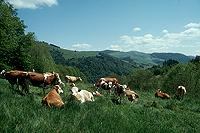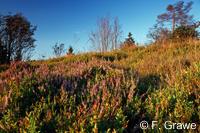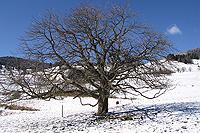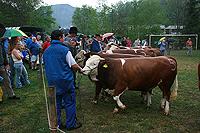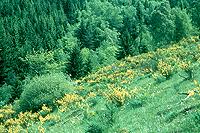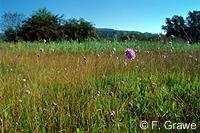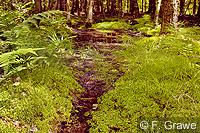The Commons in the Southern Black Forest (Germany)
Facts & Figures
- General information
- Land-use history
- The Commons of the Southern Black Forest
- Changes in the 19th century
- The survival of the commons
- Latest developments
General information
The Black Forest lies in the federal state of Baden-Württemberg in south-western Germany. This upland region extends over 4.500 km2 and reaches its highest peak with the Feldberg summit (1.500 m) in the southern part of the range. The Black Forest is typical of Central European mountain regions in general; other examples include the Bavarian Forest, Harz, Thuringian Forest, Rhön and Eifel. The population density is comparably low with 80 inhabitants per km² (Germany on average: 250 inh. per km²).
The Black Forest, from geographical and ecological viewpoints, can be divided into a northern, central and southern part. The western side is characterised by high relief, steep slopes and valleys deeply incised by high energy streams that form part of the Rhine drainage system. The eastern-orientated drainage, on the other hand, is part of the Danubian system and characterised by low relief energy, minor erosion effects and broad valleys.
Land-use history
The history of agriculture in the Black Forest has been greatly influenced by farm inheritance patterns. In the central and northern parts of the Black Forest farms were passed on as a whole, mostly to the youngest son. This resulted in holdings of considerable size which sometimes exceeded 100 ha. In contrast in the Southern Black Forest the farms were divided between all the children. This led to very small holdings and small field sizes.
Until the middle of the 19th century, agriculture in the Black Forest was of a subsistence type. Slash and burn cultivation even on steep slopes was common practise which resulted in the depletion of nutrient reserves and exhausted soils. By the end of the 18th century, forests constituted only about 30% of the total area. The reduction of tree cover resulted from demand for timber and farming land, excessive grazing of existing woodlands and shifting cultivation. Reforestation programmes commenced at the beginning of the 19th century. Since 1950 alone, woodland cover has increased by 20%. It now reaches 90% in the north and up to 70 % in the south, which is the least wooded.
The Commons of the Southern Black Forest
A relict of former farming systems still exists in the Southern Black Forest in the form of commonage. These commons (“Allmendweiden”) are a unique contribution to the German cultural and ecological heritage and are the only systems in Central Europe which have survived all agricultural reforms of the last centuries. Commonage was an important element of the Central European “Three-Field-System” and means that most of the communal area was not divided into private property during the 19th century.
The “Three-Field-System” can be described as follows: The usually fenced off dwelling sectors with farm houses, gardens and orchards (= “first circle”) was followed by a “second circle” encompassing arable cultures in a consecutive system of winter and summer cereals with fallow sites. The “third circle” which constituted up to 70 % of the community area consisted of common land that included woods, semi-open and open grassland and was used as grazings for the communal livestock. Housing of livestock and the production of winter fodder was more or less unknown until the second half of the 18th century. Therefore, most animals were kept on the common ground almost all year round or – during winter months – on harvested and fallow land closer to the village.
Changes in the 19th century
The historic pastures have to be described with attributes such as unproductive with very low carrying capacities (even at a subsistence level) and in the long run detrimental for the environment. Especially the livestock-keeping that depended on year round pasturing caused heavy damages to woods and soils. In many regions woodlands disappeared entirely. And even in mountainous areas such as in the Central German Mountain Range or in the Black Forest the woodes areas declined to less than 20 % of the total land surface.
Because of these reasons new models of agriculture were being introduced by enforced means into the rural societies in the last decades of the 18th century. The new system included elements like housing of livestock, the production of winter fodder, new crops which were grown on the previous fallows (potatoes or lucerne) and the division of the commons into private property.
The survival of the commons
Though greatly reduced in recent centuries, these extensive communal grasslands in the Black Forest still comprise about 10 000 hectares and extend over different communities. The reasons of their survival during the historic transition is complex: In the context of subsistence farming with poor structural and site conditions there was little pressure for reforms such as land consolidation. Furthermore, since the Middle ages many people also had income from work in the widespread mining sector (silver). With the industrialisation in the valleys in the 19th century and the disappearing of the mines new jobs in the emerging textile industry were available.
So farming in the Southern Black Forest was to some extent not always the central economic focus and thus preventing reforms. This special situation of the rural communities also explains why part-time farming was and still is the prevailing farm model and only few farms have ever been operated as full-time holdings (ca. 10 %).
Latest developments
In the last forty years a dramatic decline in agriculture has taken place – this of course happened in most less favoured agricultural areas in Europe. So, in the Southern Black Forest part-time and full-time farmers have declined by 70 %, and dairy cow numbers have fallen by 60 % and even 90 % in places. Meadows and pastures have been replaced by forest, the result of reforestation or natural succession.
Up to 20 years ago, livestock farms always had a dairy component. Since the beginning of 1990s, there has been a strong trend towards suckler cow systems. The economic and structural problems with growing costs for dairy systems and dwindling milk prices at the same time have been exacerbated by the unwillingness of young people to engage in farming and poor levels of training.
From nature conservation and cultural viewpoints, farming in the Black Forest and the maintenance of the commons system is highly desirable for many reasons. The traditional aim of food production is now longer of primary importance. Agriculture in these landscapes is needed for reasons similar to those in comparable regions of Europe. An active farming economy is important in that it contributes significantly to preservation of areas and biotopes of ecological importance, high biodiversity and landscapes derived from long farming traditions and hence of great cultural importance. Other benefits include maintenance of general infrastructure and areas of high amenity and educational value for urban-based populations and the tourists industry, as well as providing opportunities for the production of high quality specialist foods and the preservation of rare livestock strains.
Problems of managing the Southern Black Forest commons within the context of the CAP and conservation legislation
As described the commons in the Black Forest are genuine relicts of the medieval three-field system. Not only open grassland belongs to the commons – they also comprise semi-open and wooded areas. In general, from the past until now the commons have predominantly been used as pastures.
The Black Forest commons are a good example to illustrate the socio-economic realities of extensive grazing systems in Germany. Less favoured regions are often confronted with a rapid decline of a viable agricultural economy and especially of systems with extensive livestock keeping. Although significant amounts are paid as subsidies, these payments are not enough to maintain high nature value-oriented farming systems.
The decline of agriculture and the loss of many holdings have a complex explanation. A major threat is the situation of small-scale mountain dairy farms. Long-time overproduction in the dairy sector has resulted in steadily dwindling milk prices. On the other hand, production costs are increasing and are not compensated for by a growing level of subsidies. The official advice for remedying this situation was and still is to improve the competitiveness and to rationalize the production system.
As a consequence of this thinking farms in less-favoured areas have attempted to develop low producing areas, e.g. wood pastures and semi-open and extensive grazings, all-year housing of livestock, implementation of high energy feeding and improvement (intensive manuring and change to silage production) of the grassland economy. But these adjustments are usually accompanied by high risks and farms have reached their economic and social limits. The consequences for the countryside are obvious. An increasing shortage of livestock is necessary to continue the management of the grazing systems that often include wood pastures and semi-open grassland.
Conservation legislation
Confusing legal aspects have to be addressed when introducing the subject of designated biotopes according to nature conservation law into the pasturing issue of the commons. Historical forest sites with long-term impact of grazing livestock are often characterised by structural, floristic and faunistic features of high conservation interest. A good example are sites with pasture trees such as beech (“Weidbuchen”) and white fir which have over time developed into impressive solitary individuals due to the suppression of potential neighbouring competitors by livestock grazing.
To guarantee ecological functionality pasturing is needed but difficult to practise in various senses. More and more legal constraints mainly due to policy obligations frustrate farmers and thus result in a lack of livestock. As a result many of these historical archives are steadily losing their individuality. A second example is the situation of woody structures such as hedges and scrubby areas, which are very typical for semi-open pastureland. A conflict emerges if a conservation status has been ascribed to such structures and thus the dynamic conservation approach of extensive grazing interferes with the static ideal of conservation management.
Forestry vs. agriculture
The situation of the semi-open grazed grassland – the core areas of the commons is also crucial. Because of undergrazing or the interruption of the grazing tradition, semi-open pastures in particular are faced with scrub encroachment and a tendency towards complete tree cover. Such areas are confronted with two legal cycles, namely regulations concerning agriculture and forest law. Despite long time agricultural use and historic rights, the forest law can be interpreted in such a way that once the tree layer has reached a certain surface cover, the area will be declared as woodland. This new legal situation has the consequence that clearing measures and pasturing are no longer permitted. The forest administration interested in increasing their domain has often followed this opinion.
What were the reactions? To prevent such developments, the agricultural bodies sometimes completely removed all trees and successional stages with woody vegetation to form distinct borders between open land and forests. The ecological loss of high value ecotones and of the aesthetic peculiarities has been considerable. Although on a local basis on both sides this fundamental viewpoint has more and more been replaced by pragmatic understanding, in official bodies the “battle” for clear separation of land use systems is still inherent and practised.
Livestock
The Southern Black Forest region is also well known as the breeding area for the smallest Central European cattle breed: the Black Forest Hinterwald cattle. Today it also is one of the rarest livestock breeds with a herd book population of only 700 cows and a total number of 3.000. The cows have an average height of 1,2 m and the bulls of 1,35 m. The weight of the cows ranges between 400 and 450 kg; the bulls between 700 and 750 kg.
The breeding history is comparable to most southern German cattle breeds. Until the 1950ies it was a multi-purpose breed mainly for milk and labour; meat production was of very little importance. The Hinterwald cattle has developed in a co-evolutionary process parallel to the needs of the mountain farmer and the site conditions. The small and hardy breed with very good abilities for climbing and the exploitation of poor fodder qualities is best adapted to this mountainous region with steep slopes and long distances from the farm houses to the grazings on the high-altitude commons.
Grassland types
The commons of the Black Forest are especially important for several very special grassland types, which fall under the EU Habitat directive – notably “Species-rich formations with Nardus stricta on silicious substrates” (EU Code *6230) and “Mountain hay meadows” (EU Code 6520).
The following table describes high nature value biotopes as listed in the habitats directive. The descriptors are: Code-number, type, main vegetation types according to official nomenclature, birds as indicative species, remarks on management/agricultural use.
| NATURA 2000-Code: | 6230 |
|---|---|
| Type of biotope: | Formation with Nardus stricta on silicious substrates in mountain areas |
| Vegetation: (according to scientific nomenclature) |
|
| Indicator species (birds): | Anthus spinoletta, Anthus trivialis, Caprimulgus europaeus, Lululla europea, Tetrao tetrix, Saxicola rubetra, Saxicola torquata |
| Area (hectare): | Probably less than 10.000 hectares in Germany with a species-rich performance of which ca. 5.000 hectares are located in the Black Forest, mainly in the South. |
| Related agricultural management: |
Extensive grazing with sheep, cattle or/and management as extensive hay-meadows |
| NATURA 2000-Code: | 6520 |
|---|---|
| Type of biotope: | Mountain hay meadows |
| Vegetation: (according to scientific nomenclature) |
|
| Indicator species (birds): | Anthus pratensis, Anthus spinoletta, Oenanthe oenanthe, Prunella collaris |
| Area (hectare): | No data |
| Related agricultural management: |
Traditional lowland hay meadow (2 cuts, moderately fertilised), Traditional small-scale dairy farms |


